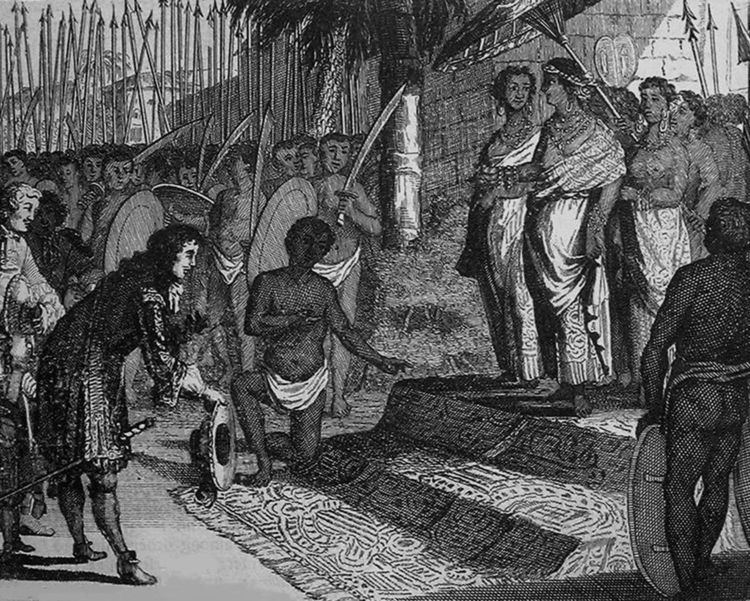 | ||
Aswathi Thirunal Umayamma, popularly known as Umayamma Rani, was the Regent of Venad from 1677 to 1684 on behalf of her nephew Rajah Ravi Varma who ruled thereafter till 1718.
Contents
State of Venad
Venad or Travancore was at that time in a state of turmoil. The two predecessors of Umayamma Rani, Rama Varma and Aditya Varma, had been adopted from the Vellarapally branch of the Cochin Royal Family in 1630, thereby offending the legitimate claims of the collateral branches of the Venad royal family to the musnud. These collateral branches therefore started exercising independent authority in their domains. They were Elayadathu Swaroopam of Kottarakara, Peraka Thavazhi of Nedumangad and Desinganad Swaroopam of Quilon. Besides, even within the limited domains of the kingdom remaining with the chief branch, factions were rife due to the refractory nobles or madempis, most famous of whom were the Ettuveetil Pillamar.
The Royal Family
Excluding the collateral branches, the members at the time of Umayamma Rani's rule in the Royal family of Venad were Makayiram Thirunal, the Senior Rani of Attingal, Umayamma Rani herself as Junior Rani of Attingal and Makayiram Thirunal's son, Rajah Ravi Varma. In 1677, Kerala Varma of Nedumangad laid claim to the musnud but his claim was rejected. Umayamma Rani also adopted in the same year two boys, solely for domestic purposes, with no claims to the throne, namely Raman Koyil Pandarathil, from Vellarapalli, Cochin and Kochu Raman Unni Pandarathil, a Brahmin boy. Kerala Varma of Nedumangad along with the Kottarakara branch even attempted a military coup in 1682. On failure they tried to conciliate the Senior Rani of Attingal, Makayiram Thirunal but even this failed.
Adoption of Heirs
It is generally believed that Umayamma Rani had six sons of whom five were drowned by the Ettuveetil Pillamar and that Ravi Varma was her eldest and only surviving son. However, with the help of the records of the Padmanabhaswamy temple in Trivandrum and other credible sources, modern historians have not only disproved this fable but also positively concluded that Umayamma Rani did not have any children at all. Similarly the story of the poisoning of Rajah Aditya Varma has also been disproved and it is now clear that he died a natural death in 1677 at Darpakulangara Palace.
In 1682 the Senior Rani of Attingal died and Umayamma Rani succeeded as principal Queen of Venad. The Royal family followed Marumakkathayam or matrilineal system of inheritance and family for which presence of females in the royal family were essential. In 1682 Umayamma Rani adopted one male, Aditya Varma, and two females from the related Kolathunad Royal family. This was followed by war with an enraged Kerala Varma of Nedumangad which the Rani won and the claims of the Nedumangad family were found to be untenable. In 1684 Umayamma Rani also adopted an adult male from the related Royal family of Kottayam, Malabar, a branch of the Kolathunad house. This adopted male was Kerala Varma and was given the title of 'Prince of Hiranyasimhallur' (Eraniel). This prince took the reins of the kingdom into his hands by first silencing the collateral branches and asserting the power of the chief branch. During that period a Mughal raider invaded Venad in 1684 with his army. Kerala Varma defeated him in the battle near Thuckalay. He also abolished certain abhorrent customs known as Pulappedi, Mannapedi etc. in 1695. Since he was consolidating the royal power, the nobles of the land and the temple trustees (Ettara Yogam) murdered him in 1695 and his obsequies were performed by Aditya Varma. Meanwhile, Ravi Varma became the Rajah and in 1688 adopted two males, Unni Kerala Varma and Rajah Rama Varma from Kolathunad, and two princesses from Kolathunad. The succession continued in these lines and again adoptions were made in 1705, 1718 and so on.
Description of Umayamma Rani
The Dutch representative William Van Nieuhoff describes the Rani as:
